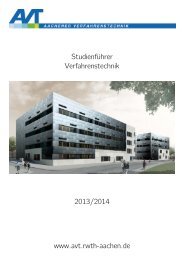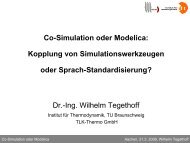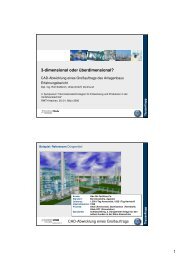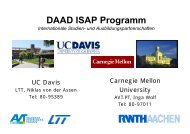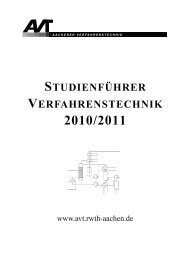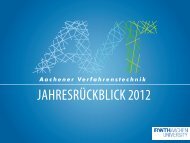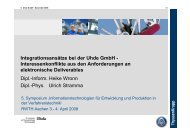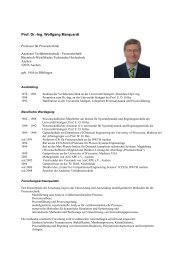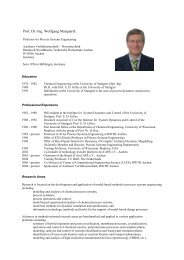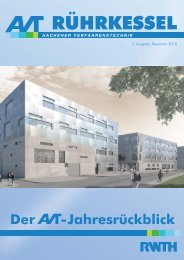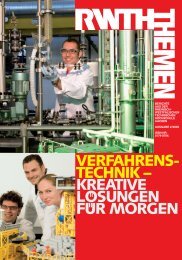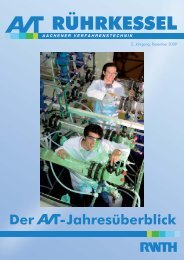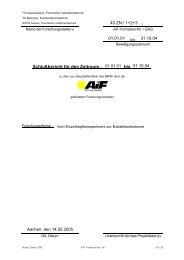Newsletter - Aachener Verfahrenstechnik - RWTH Aachen University
Newsletter - Aachener Verfahrenstechnik - RWTH Aachen University
Newsletter - Aachener Verfahrenstechnik - RWTH Aachen University
Create successful ePaper yourself
Turn your PDF publications into a flip-book with our unique Google optimized e-Paper software.
To tackle this drawback, new membrane materials<br />
as well as multi stage gas permeation<br />
concepts can significantly reduce methane losses.<br />
Hence, gas permeation becomes competitive<br />
to conventional separation equipment. Recently,<br />
we investigate membrane based as well<br />
as conventional biogas upgrading equipment. In<br />
a first step we analyze various commercial gas<br />
permeation modules which are able to separate<br />
carbon dioxide and methane. The separation<br />
performance is specified by experimental data<br />
obtain on a gas permeation test facility. Here,<br />
we can mix and analyze up to seven gases and<br />
add water vapor. We developed a comprehensive<br />
model of a gas permeation module which relies<br />
on the experimental obtained data and which<br />
can be applied in process simulation. Thus, gas<br />
permeation processes as well as hybrid processes<br />
in which membrane technology and conventional<br />
separation equipment are combined can<br />
be analyzed. The simulation results will be implemented<br />
in a commercial scale biogas upgrading<br />
plant.<br />
Fig.5: Biogas plant<br />
News on the ion exchange technology - bipolar<br />
membranes<br />
Electrodialysis (ED) is a well-established electrochemical<br />
membrane separation process. It<br />
separates different charged species using ionexchange<br />
membranes. Ion exchange membranes<br />
are polymeric membranes with fixed charges<br />
attached to the membrane matrix. Depending<br />
on the type of ions, the membrane can hold<br />
back anions or cations. A special type of ion exchange<br />
membranes are the bipolar membranes<br />
(BPM). These membranes consist of an anion<br />
layer attached to a cation layer. Water diffuses<br />
in the membrane during a process. In an electric<br />
field the water inside the BM will dissociate and<br />
the ions will leave the membrane resulting in an<br />
increased or decreased pH of the solution adjacent<br />
to the membrane. Consequently ED with<br />
BPM is the only known process applicable for<br />
acidification/alkalization without the use of additional<br />
chemicals.<br />
Water supply to the membrane is one of the main<br />
factors that limit its applications. The New-ED<br />
project, coordinated by AVT.CVT, aims to improve<br />
the water transport in the membrane, by manufacturing<br />
new type of bipolar membrane with<br />
porous intermediate layers or channels . These<br />
channels directly provide water for the water<br />
splitting, thus increasing the process efficiency.<br />
Fig.6: New concept for bipolar membranes<br />
(Quelle: Balster J., PhD Thesis, UT<br />
Twente, Enschede, NL, 2006)<br />
One possible application of the new BM is the<br />
electrodialysis with bipolar membranes (EDBM)<br />
in the excellence cluster TMFB. TMFB aims at<br />
producing fuels from renewable sources which<br />
do not compete with the food chain. In the process,<br />
biomass is fermented and the liquid containing<br />
a platform chemical is removed. Afterwards<br />
the platform chemical is acidified in the EDBM,<br />
to obtain higher yields in an extraction step that<br />
follows the EDBM. The aqueous phase of the<br />
extraction is recycled to the EDBM for alkalization,<br />
which is afterwards is used to control pH of<br />
the fermenter. The main focus of the work on the<br />
EDBM in the TMFB cluster is to find the optimal<br />
process control, with improved efficiency of the<br />
whole integrated process.<br />
The AVT <strong>Newsletter</strong> Chemical Process Engineering 10



